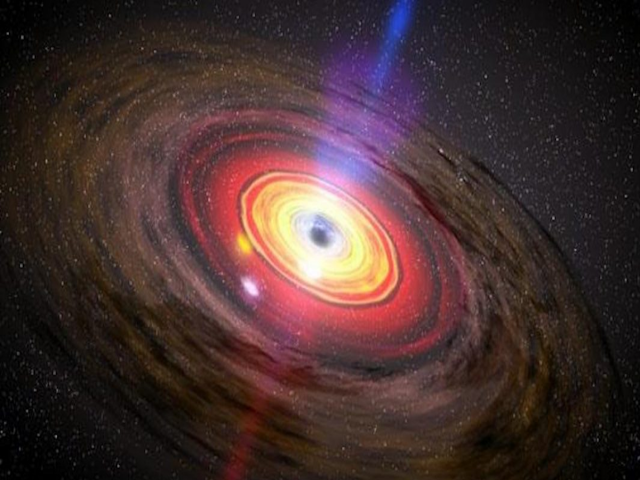Siamo molto più vicini al buco nero al centro della galassia / We are much closer to the black hole at the center of the galaxy
Siamo molto più vicini al buco nero al centro della galassia / We are much closer to the black hole at the center of the galaxy
Segnalato dal Dott. Giuseppe Cotellessa / Reported by Dr. Giuseppe Cotellessa
Siamo più vicini di 2mila anni luce al Sagittarius A*, il buco nero al centro della nostra galassia che ha una massa di circa 4 milioni di volte quella del Sole, di quanto stimato finora. A raccontarlo è un nuovo studio dei ricercatori di un progetto giapponese di astrometria, branca che si occupa delle misurazioni, posizioni e movimenti dei copri celesti, che hanno messo a punto una nuova mappa tridimensionale della Via Lattea, dimostrando che non solo siamo più vicini al buco nero supermassiccio, ma anche che ci muoviamo a una velocità leggermente superiore di quella stimata fino ad ora. Precisiamo fin da subito che non c’è motivo di preoccuparsi: questi dati, pubblicati su Publications of the Astronomical Society of Japan, non significano che ci stiamo avvicinando a un buco nero, ma piuttosto che questa nuova mappa ci offre una misura più accurata della distanza tra noi e Sagittarius A*.
Il buco nero più vicino
Dopo ben 15 anni di raccolta dati, attraverso la tecnica dell’interferometria, provenienti dai telescopi di tutto il Giappone (per avere una risoluzione pari a un telescopio di 2.300 chilometri di diametro) i ricercatori del progetto Vera, che sta per Vlbi (Very Long Baseline Interferometry) Exploration of Radio Astrometry, li hanno combinati con i dati di altre osservazioni recenti per creare quella che è essenzialmente la mappa tridimensionale di posizione e velocità più accurata della Via Lattea.
Identificando poi la posizione e la velocità di circa 99 oggetti celesti, il team è riuscito a calcolareche il buco nero supermassiccio al centro della nostra galassia è in realtà a 25.800 anni luce dalla Terra, e quindi quasi 2mila anni luce più vicinorispetto a quanto stimato in precedenza. Nel 1985, infatti, l’Unione astronomica internazionale lo aveva individuato a 27.700 anni luce da noi, mentre l’anno scorso era stato ricalcolato e posizionata a una distanza minore, pari a 26.673 anni luce.
La Terra è più veloce
Dai risultati, inoltre, è emerso che la Terra si sta muovendo più velocemente di quanto credessimo. Secondo alcuni modelli precedenti, infatti, la sua velocità orbitale si aggirava intorno ai 220 chilometri al secondo, mentre secondo i risultati della nuova mappa il nostro pianeta starebbe viaggiando a una velocità maggiore, pari a 227 chilometri al secondo. I ricercatori sperano ora di perfezionare ulteriormente la mappa, osservando in particolare gli oggetti più vicini al buco nero e collaborando con un progetto ancora più grande, l’East Asian Vlbi Network, per aumentare la gamma di radiotelescopi coinvolti (Giappone, Corea del sud e Cina) e arrivare a misurazioni con una precisione senza precedenti.
ENGLISH
We are 2,000 light years closer to Sagittarius A *, the black hole at the center of our galaxy that has a mass of about 4 million times that of the Sun, than has been estimated so far. To tell it is a new study by researchers of a Japanese astrometry project, a branch that deals with the measurements, positions and movements of the celestial covers, who have developed a new three-dimensional map of the Milky Way, showing that we are not only closer to the supermassive black hole, but also that we are moving at a slightly faster speed than estimated so far. We point out right away that there is no reason to worry: these data, published in Publications of the Astronomical Society of Japan, do not mean that we are approaching a black hole, but rather that this new map offers us a more accurate measure of the distance between us and Sagittarius A *.
The closest black hole
After 15 years of data collection, using the interferometry technique, from telescopes all over Japan (to have a resolution equal to a telescope of 2,300 kilometers in diameter) the researchers of the Vera project, which stands for Vlbi (Very Long Baseline Interferometry) Exploration of Radio Astrometry, combined this with data from other recent observations to create what is essentially the most accurate three-dimensional map of the Milky Way's position and velocity.
By then identifying the position and velocity of about 99 celestial objects, the team was able to calculate that the supermassive black hole at the center of our galaxy is actually 25,800 light-years from Earth, and therefore nearly 2,000 light-years closer than estimated in precedence. In 1985, in fact, the International Astronomical Union had identified it at 27,700 light years from us, while last year it was recalculated and positioned at a shorter distance, equal to 26,673 light years.
Earth is faster
The results also showed that the Earth is moving faster than we thought. According to some previous models, in fact, its orbital speed was around 220 kilometers per second, while according to the results of the new map our planet would be traveling at a greater speed, equal to 227 kilometers per second. The researchers now hope to refine the map further, notably by observing objects closest to the black hole and collaborating with an even larger project, the East Asian Vlbi Network, to increase the range of radio telescopes involved (Japan, South Korea and China) and arrive at measurements with unprecedented accuracy.
Da:
https://www.galileonet.it/buco-nero-galassia/




Commenti
Posta un commento